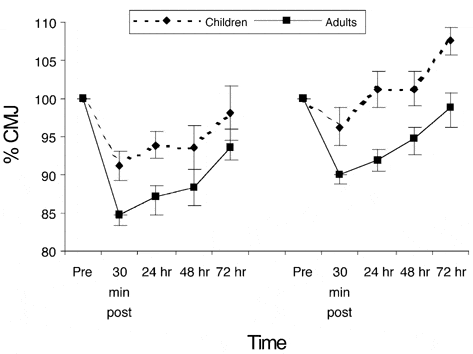Exercise-induced muscle damage (EIMD), particularly that involving eccentric muscle action is well documented in adults. Symptoms of EIMD are attenuated by previous EIMD (Morgan & Allen, 1999). Research focusing on EIMD in children has been equivocal. It is unknown if previous EIMD provides a protective effect in children.
Ten men (mean age 22.2 ± 2.7 years) and 10 boys (age 9.9 ± 0.32 years), performed eight sets of ten plyometric jumps separated by a 1 min rest, on two different occasions, separated by 2 weeks. Measures of soreness, isometric strength, squat jump (SJ) and counter movement jump (CMJ) height, were recorded immediately before, 30 min and 24, 48 and 72 h after exercise. Strength, SJ and CMJ are reported as a proportion of baseline values. Informed consent was obtained from all participants in the study, which received local area ethics approval. Data were analysed with two-factor (bout X time) and three-factor (group X bout X time) ANOVAs. Significant findings were followed up using an adapted Tukey’s test (Stevens, 1996). All values are given as means ± S.D.
Both groups experienced less soreness following bout 2, although boys experienced less soreness than men after both bouts of exercise (0.8 ± 0.9, 0.2 ± 0.9, for boys cf. 3.7 ± 1.0, 1.8 ± 1.0 for men, for bouts 1 and 2, respectively). Soreness in boys recovered faster following both bouts (P < 0.05). There was a repeated bout effect for men only for SJ (97.4 ± 3.8 and 98.4 ± 3.4 % for boys, cf. 88.6 ± 3.5 and 94.9 ± 3.6 % for men, for bouts 1 and 2, respectively, P < 0.05). However, % CMJ demonstrated a repeated bout effect for both groups (Fig. 1). Boys experienced less of a decline in % CMJ (Fig. 1) and % SJ following both bouts of exercise (P < 0.05). For strength, there was a repeated bout effect for men (83.8 ± 8.2 cf. 90.3 ± 5 %, P < 0.05), but no repeated bout effect on strength was observed for boys. Expressed as a proportion of baseline values, strength was higher in boys after both bouts (97.8 ± 11.6 and 102 ± 6.6 % for boys, cf. 82.6 ± 11.7 and 90.7 ± 6.8 % for men, P < 0.05).
In conclusion the severity of the symptoms of EIMD was lower in boys. A prior bout of plyometric exercise attenuates soreness and decrements in CMJ in boys, and all symptoms of EIMD in men.

